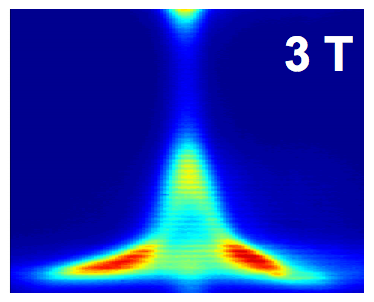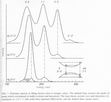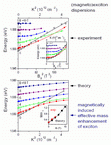Transport of indirect excitons in high magnetic fields |
|

|
We present spatially- and spectrally-resolved photoluminescence measurements of indirect excitons in high magnetic fields. Long indirect exciton lifetimes give the opportunity to measure magnetoexciton transport by optical imaging. Indirect excitons formed from electrons and holes at zeroth Landau levels (0e − 0h indirect magnetoexcitons) travel over large distances and form a ring emission pattern around the excitation spot. In contrast, the spatial profiles of 1e−1h and 2e−2h indirect magnetoexciton emission closely follow the laser excitation profile. The 0e − 0h indirect magnetoexciton transport distance reduces with increasing magnetic field. These effects are explained in terms of magnetoexciton energy relaxation and effective mass enhancement. Y. Y. Kuznetsova, C. J. Dorow, E. V. Calman, L. V. Butov, J. Wilkes, K. L. Campman, and A. C. Gossard. Transport of indirect excitons in high magnetic fields, arXiv:1610.03116v1 (2016), Phys. Rev. B 95, 125304 (2017). We present the direct measurements of magnetoexciton transport. Excitons give the opportunity to realize the high magnetic field regime for composite bosons with magnetic fields of a few Tesla. Long lifetimes of indirect excitons allow the study kinetics of magnetoexciton transport with time-resolved optical imaging of exciton photoluminescence. We performed spatially, spectrally, and time-resolved optical imaging of transport of indirect excitons in high magnetic fields. We observed that increasing magnetic field slows down magnetoexciton transport. The time-resolved measurements of the magnetoexciton transport distance allowed for an experimental estimation of the magnetoexciton diffusion coefficient. An enhancement of the exciton photoluminescence energy at the laser excitation spot was found to anti-correlate with the exciton transport distance. A theoretical model of indirect magnetoexciton transport is presented and is in agreement with the experimental data. C. J. Dorow, M. W. Hasling, E. V. Calman, L. V. Butov, J. Wilkes, K. L. Campman, and A. C. Gossard. Spatially and time-resolved imaging of transport of indirect excitons in high magnetic fields, arXiv:1705.09077 (2017), Phys. Rev. B 95, 235308 (2017). |
Magnetic field effect on indirect excitons |
|

|
Exciton dispersion measurement and controlMagnetic field was experimentally shown to be an effective tool for a measurement and control of quasi-2D exciton effective mass and dispersion relation.When an in-plane magnetic field is applied, the exciton dispersion surface shifts. This results to the transition from the momentum-space direct exciton ground state to the momentum-space indirect exciton ground state and, consequently, to a strong enhancement of the indirect exciton lifetime, thus further lowering the indirect exciton effective temperature. Application of in-plane magnetic fields also allows measurement of the exciton dispersion. Perpendicular magnetic fields result in enhancement of the effective mass of QW excitons. This effect originates from the coupling between the exciton internal structure and center of mass motion induced by magnetic field. L.V. Butov, A.V. Mintsev, Yu.E. Lozovik, K.L. Campman, and A.C. Gossard, From spatially-indirect to momentum-space-indirect exciton by in-pane magnetic field, Phys. Rev. B 62, 1548 (2000). L.V. Butov, C.W. Lai, D.S. Chemla, Yu.E. Lozovik, K.L. Campman, and A.C. Gossard, Observation of magnetically induced effective mass enhancement of quasi 2D excitons, Phys. Rev. Lett. 87, 216804 (2001). Yu.E. Lozovik, I.V. Ovchinnikov, S.Yu. Volkov, L.V. Butov, and D.S. Chemla, Quasi two-dimensional excitons in finite magnetic fields, Phys. Rev. B 65, 235304 (2002). |

|
Effect of perpendicular magnetic field on exciton condensationThe effect of perpendicular magnetic field on the quantum degeneracy of the 2D exciton gas and the exciton condensation has a complicated character. There are "good" effects, which increase the quantum degeneracy and improve the critical conditions for the exciton condensation, and there are "bad" effects, which reduce the quantum degeneracy and suppress the exciton condensation.Yu.E. Lozovik, I.V. Ovchinnikov, S.Yu. Volkov, L.V. Butov, and D.S. Chemla, Quasi two-dimensional excitons in finite magnetic fields, Phys. Rev. B 65, 235304 (2002). |
Magnetoexciton energies |
|

|
We report on the (magneto-) optical study of many-body effects in spatially separated electron and
hole layers in GaAs/AlxGa1 – xAs coupled quantum wells (CQWs) at low temperatures (T = 1.4 K) for a broad
range of electron–hole (e–h) densities. Coulomb effects were found to result in an enhancement of the indirect
(interwell) photoluminescence (PL) energy with increasing the e–h density both for a zero magnetic field and
at high fields for all Landau level transitions; this is in contrast to the electron–hole systems in single QWs
where the main features are explained by the band-gap renormalization resulting in a reduction of the PL
energy. The observed enhancement of the ground state energy of the system of the spatially separated electron
and hole layers with increasing the e–h density indicates that the real space condensation to droplets is energetically
unfavorable. At high densities of separated electrons and holes, a new direct (intrawell) PL line has been
observed: its relative intensity increased both in PL and in absorption (measured by indirect PL excitation) with
increasing density; its energy separation from the direct exciton line fits well to the X– and X+ binding energies
previously measured in single QWs. The line is therefore attributed to direct multiparticle complexes.
L.V. Butov, A. Imamoglu, K.L. Campman, and A.C. Gossard, Coulomb Effects in Spatially Separated Electron and Hole Layers in Coupled Quantum Wells, Journal of Experimental and Theoretical Physics 92, 260 (2001). We report on the magneto-optical study of the spatially separated electron and hole layers in GaAs/AlxGa12xAs coupled quantum wells at low temperatures T>50 mK and high magnetic fields B <16 T. At high magnetic fields cusps are observed in the energy and intensity of the indirect ~interwell! exciton photoluminescence. We tentatively attribute these to the commensurability effects of the magnetoexciton with island structures in the sample. The indirect exciton lifetime is found to increase with magnetic field. The increase is attributed to the reduction of indirect exciton localization area caused by the increase of the magnetoexciton mass. The indirect exciton photoluminescence energy is found to enhance with density, which reflects the net repulsive interaction between indirect excitons.L.V. Butov, A.A. Shashkin, V.T. Dolgopolov, K.L. Campman, A.C. Gossard, Magneto-optics of the spatially separated electron and hole layers in GaAs/AlGaAs coupled quantum wells, Phys. Rev. B 60, 8753 (1999). Spatially direct (intrawell) and indirect (interwell) excitons in symmetric InxGa1−xAs/GaAs coupled quantum wells were studied by photoluminescence and photoluminescence excitation spectroscopy at magnetic fields B≤14 T. The regimes of zero and high electric fields in the growth direction as well as the transition between them were examined. The magnetic field changes the ratio between the one-particle symmetric-antisymmetric splittings and the exciton binding energies. This was found to result in a strong influence on the energies and oscillator strengths of the optical transitions both at zero and finite electric fields. The direct-indirect exciton crossover under applied electric field was found to be markedly modified by the magnetic field due to the increase of the exciton binding energy.L.V. Butov, A. Zrenner, G. Abstreiter, A.V. Petinova, K. Eberl, Direct and indirect magnetoexcitons in symmetric InGaAs/GaAs coupled quantum wells, Phys. Rev. B 52, 12153 (1995). |
Excitons in dense magnetoplasmas |
|

|
Cooling of a dense plasma to low temperatures (~ 50K ~ TdB at n ~ 1012 cm-2) was achieved in single InGaAs/InP QW structures due to relatively long lifetimes. Excitons form at the Fermi level of a dense electron-hole magnetoplasma in single QWs. L.V. Butov, V.D. Kulakovskii, E.I. Rashba, Excitons and deexcitons in a neutral 2D magnetoplasma with an integer filling of Landau levels: experiment and theory, Pis'ma Zh. Eksp. Teor. Fiz. 53, 104 (1991) [Sov. Phys. JETP Lett. 53, 109 (1991)]. L.V. Butov, V.D. Kulakovskii, G.E.W. Bauer, A. Forchel, D. Grützmacher, Excitons in dense two-dimensional electron-hole magnetoplasmas, Phys. Rev. B 46, 12765 (1992). L.V. Butov, V.D. Kulakovskii, A. Forchel, Spin splitting renormalization in the neutral dense magnetoplasma in InGaAs/InP quantum wells, Phys. Rev. B 48, 17933 (1993). |



